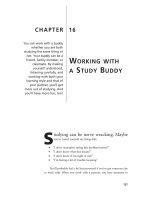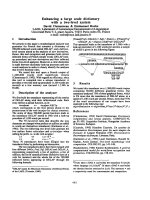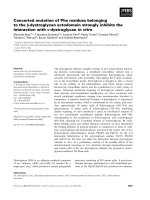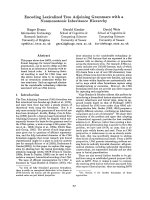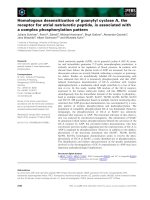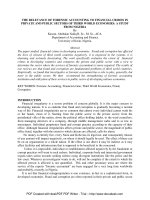Working with a study budy 7 pot
Bạn đang xem bản rút gọn của tài liệu. Xem và tải ngay bản đầy đủ của tài liệu tại đây (43.66 KB, 6 trang )
167
CHAPTER
20
KNOWING WHEN
YOU NEED HELP
As you’ve seen
throughout this book,
everyone learns differently.
Everyone has strong
and weak areas of the
brain. But what if your
weak area is really weak,
so weak that it’s
preventing you from
accomplishing your goals,
even when you’re working
hard? This chapter helps
you figure out when you
need help with a learning
difference that may be a
learning disability.
E
veryone learns in unique ways. Remember
how Chapter 2, “Discovering How You Learn,” described us all
as learning seesaws? It’s unusual for anyone’s seesaw to be
perfectly level. It’s up on the side where you’re a strong learner, and
down where your learning is less strong.
If your seesaw is very tilted because you’ve got a super-strong
learning style that’s bringing that side all the way up, you’re often
paying a price for it. In order to balance out that super strength,
another learning style may be difficult for you. Everyone has a learning
HOW TO STUDY
168
difference. But in some people, the difference is so pronounced it gets in
the way of learning. An extreme weakness in acquiring or expressing
knowledge is called a learning disability. If you have a learning disability,
you’re not alone; 8 to 15 percent of people in the U.S. have some kind of
learning disability.
COMPENSATING FOR A DISABILITY
In Chapters 2 through 5, you looked at the different ways people learn. In
Chapters 7 and 8, you thought about when you know something for sure,
and when something’s not clear to you. You may want to review these
chapters before continuing. For example, someone who is a real whiz in
math, and very strong on order—a sequential learner—might have little
interest in reading stories or watching fictional movies. Or, someone could
be an amazing auditory learner, learning predominately by hearing, yet
have difficulty spelling. For most people, strengths and weaknesses bal-
ance each other out.
Most people who have a learning disability don’t know that they
have it. They know, on some level, that something’s not quite right, but
they’ve naturally been compensating for it. The person who is uncom-
fortable reading, for example, might be an avid radio listener and an
engaging speaker.
Those who do know they have a learning disability are often unclear
about what it is. Perhaps they were diagnosed in grammar or high school,
perhaps they were even in special classes or met regularly with an educa-
tional specialist, but they still might not know exactly why they were
there. And, often those who know what kind of learning disability they
have don’t know what to do about it.
The solution is to find out how you learn best, to know when you
need help, and to know where to go to get it!
GETTING HELP
You’ve already begun helping yourself, even before you started reading
this book. You are making up for your learning difficulty in some way,
even if you don’t know it.Your brain does this to protect and help you. But
there’s a limit to how much compensating your mind can do. You may
have a learning difficulty if you often find yourself saying things like this:
KNOWING WHEN YOU NEED HELP
169
• I know the words in this sentence, but I just can’t make sense of it.
• I know this person is talking, but I don’t understand what they’re
talking about.
• I recognize the numbers and math signs, but I don’t know how to
do the problem.
• I know I knew it once, but I don’t know what it is now.
OUTSIDE
HELP
There are organizations listed in the Appendix that you may find useful.
But help might be closer than you think.
Some schools and companies have tutoring available. They may also
have consultants you can talk with. Often, these people can put you in
touch with a learning specialist.
• If you’re with a company, check your human resources department.
• If you’re with a school, check the advisement and counseling offices.
When your seesaw is tilted to the point that your weaker way of learn-
ing is damaging your self-confidence and keeping you from accomplishing
your goals, you may have a learning disability. Most people with learning
disabilities have average or above-average intelligence. If this is you, you’re
in good company. Albert Einstein, who made a great impact on physics,
but couldn’t count his change for the bus; and Winston Churchill, who
made a great political and historical impact, but couldn’t spell, are just two
of the world’s geniuses who had learning disabilities.
WHAT DO I LOOK FOR?
TYPES OF DISABILITIES
While there are many, many different kinds of learning disabilities, you’ll
read only about the common ones here. See the Appendix for sources of
more information on all types.
If you should be diagnosed as having a learning disability (or combi-
nation of disabilities), you might feel relieved. “Ah!” you might say,“there’s
a name for this and it can be dealt with!”
HOW TO STUDY
170
Dyslexia
Harold is dyslexic. His eyes see just fine, but the message from his eyes to
his brain sometimes gets interrupted. Letters sometimes look like they’re
dancing on the page. Harold has to pay close attention to what he reads,
and when he can, he gets books and hand-outs printed in large type. A
tutor helped him learn to break words down into parts so he could read out
loud and spell with fewer errors. He pays such close attention that he can
read a page upside-down.
Auditory Processing Difficulties
Tami’s ears hear fine, but the message from her ears to her brain is some-
times garbled and sounds like she’s listening on a phone with a poor con-
nection. Sometimes it comes through clearly, sometimes not. She deals with
this by taking notes and asking questions. She also asks teachers to write on
the board and give her hand-outs.
Attention Deficit Disorder
Maude was born with an excessive need for attention, and she usually has
difficulty paying attention to something for longer than ten minutes at a
time. But for those ten minutes, she can really concentrate. She asks per-
mission to sit by the instructor, so she’ll be less likely to be distracted. She
has learned to live with distraction; in fact, she has learned to use it to her
advantage. She can work on several projects at the same time.
Short-Term Memory Difficulties
It is a real challenge for Jake to remember something recently said. He
deals with it by carrying a notepad with him at all times, writing down
what he wants to remember. When he’s listening to a lecture, he tapes it
so he can later replay it, a few minutes at a time. Each time he listens, he
writes down what he wants to remember.
G
ET TO
KNOW YOUR STRENGTHS AND WEAKNESSES
Generally, we can all use help when it comes to learning. It’s rare that
any of us have perfectly balanced seesaws. Be aware of when you’re under-
standing a concept you’re working to figure out. Keep a log of what’s hap-
pening to you. Look for patterns—of situations that are troublesome and
Practice Tip
Keep track of yourself daily! When are you at your best: most confident,
focused, and clear-headed? What is it that distracts you when you try to
concentrate?
In a notebook, track yourself for at least a week. If it’s reading you’re
concerned about, focus on reading. Concentrate on making things a lit-
tle more comfortable than usual. For example, if you’re eating cereal
and reading the box and you suddenly realize that reading is easier for
you than usual, write down the situation: “yellow box, green large let-
ters, my eyes looking down.” You may very well find that switching to
large-type books is a help, and so is using yellow note paper instead of
white. If you discover that you’re really enjoying your new class because
the teacher often explains concepts in big circles with connecting lines
between them, make note of it and try to repeat it in other learning
situations.
KNOWING WHEN YOU NEED HELP
171
situations that are helpful. Write in your log at least once each day. After a
week or two, you should have a clearer picture of how you learn.
If you are meeting with someone at your school or workplace such
as a learning consultant, psychologist, or tutor, bring your log and review
it with her. The service is usually free for you. When you take an active
part in diagnosing your learning weakness, you’ll be better able to con-
trol it, and even use it to your advantage.
IN SHORT
You’re a unique learner. You’re different from everyone else—and
everyone else is different from everyone else! Each of us has a learning
difference. When you realize how your seesaw of learning strength and
weakness operates, you can use your strength to get a handle on the
learning weakness. You might even find a way to use it to your advantage!
